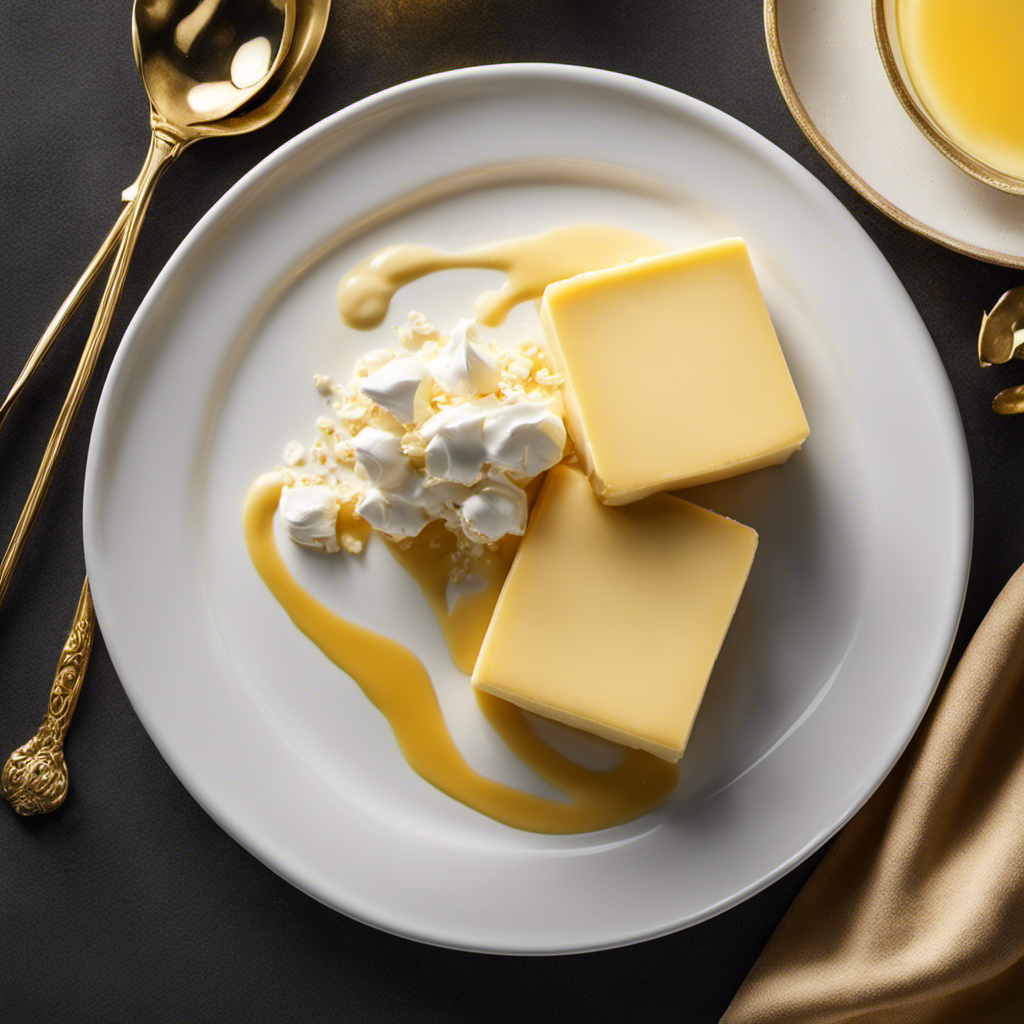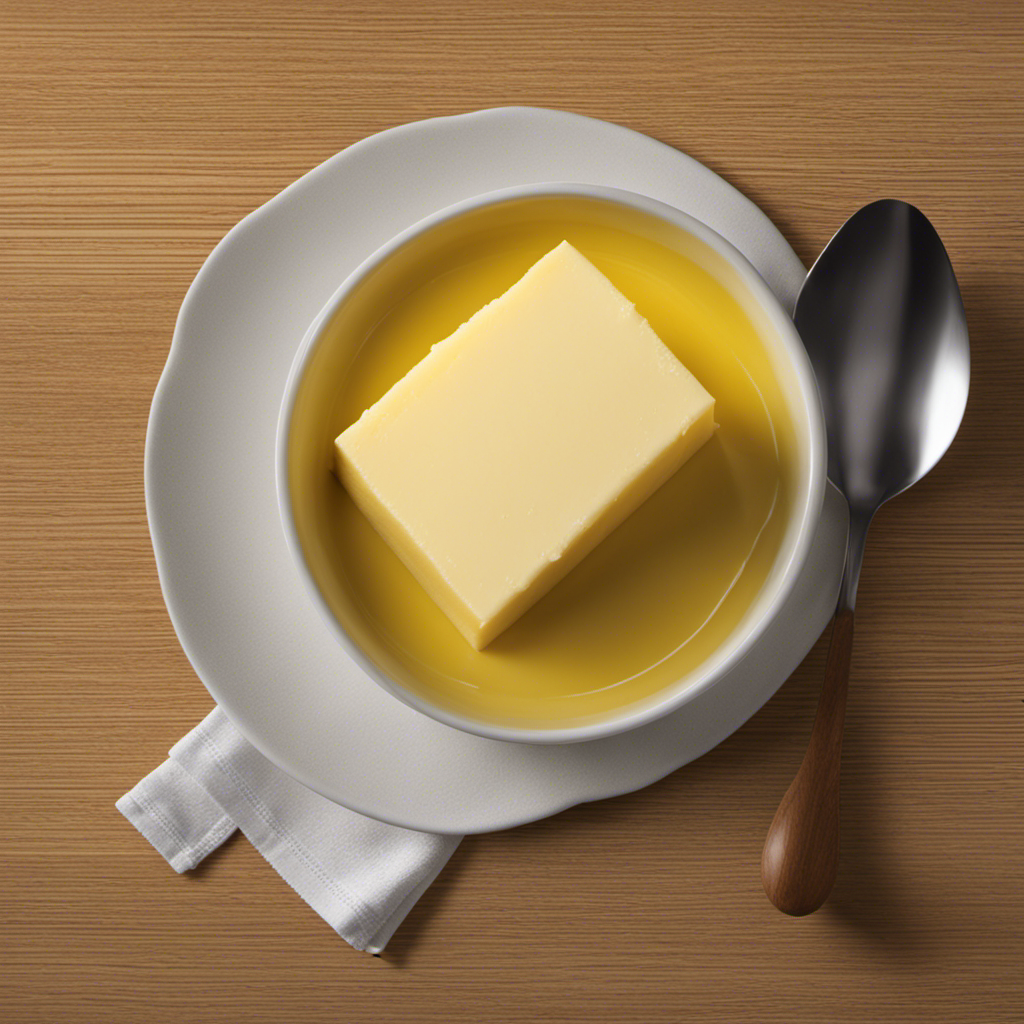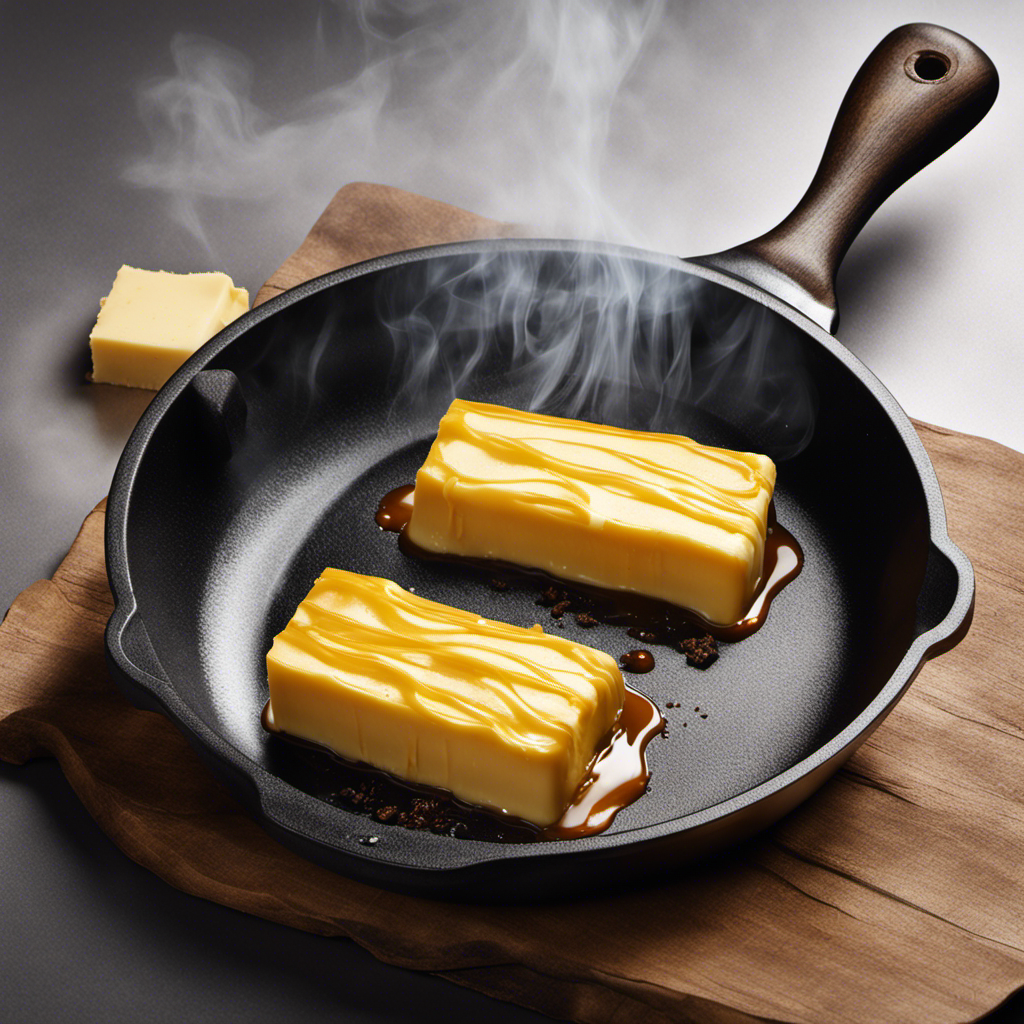I’ve always been curious about the calorie count in a baked potato topped with butter. Get ready to be astounded!
Did you know that a typical baked potato with butter contains around 250 calories? That’s right, this seemingly innocent side dish can pack quite a punch in the calorie department.
But fear not, because in this article, we will dive deep into the nutritional profile of baked potatoes with butter, uncovering the fat, carbohydrate, protein, vitamin, and mineral content.
So, let’s dig in and discover the truth behind this popular indulgence!
Key Takeaways
- Adding butter to a baked potato significantly increases its calorie content.
- Butter is high in fat and can double or triple the fat content of a plain baked potato.
- Baked potatoes with butter should be enjoyed in moderation and balanced with other nutritious foods.
- Choosing healthier alternatives to butter, such as Greek yogurt or salsa, can reduce saturated fat intake.
Nutritional Profile of Baked Potatoes With Butter
You’ll be happy to know that baked potatoes with butter have a delicious flavor and provide essential nutrients. When it comes to carb content comparison, baked potatoes are a great choice. A medium-sized baked potato contains around 37 grams of carbohydrates, which is a moderate amount compared to other starchy foods.
However, if you’re looking for healthier topping alternatives, consider swapping out the butter for options like Greek yogurt or salsa. Greek yogurt adds a creamy texture and a boost of protein, while salsa provides a flavorful kick without adding extra calories.
Another option is to top your baked potato with steamed vegetables like broccoli or spinach, which adds vitamins and fiber to your meal. Experiment with different toppings to find your favorite combination!
Calorie Content of Baked Potatoes With Butter
There’s a significant difference in the calorie content when you add butter to a baked potato. Adding butter to a baked potato can significantly increase the overall calorie count. Here are some key points to consider:
- Butter is high in fat, with approximately 100 calories per tablespoon.
- A medium-sized baked potato without butter contains about 160 calories.
- Adding a pat of butter to a baked potato can add an additional 100 calories or more.
- The carb content of a baked potato remains the same, regardless of adding butter.
When considering the impact of butter on the calorie count of a baked potato, it’s important to remember that the fat content in butter is what significantly increases the overall calorie content. If you’re watching your calorie intake, it may be helpful to limit or substitute the amount of butter used on your baked potato.
Fat Content in Baked Potatoes With Butter
When adding butter to a baked potato, the fat content is what significantly increases. Butter is high in fat, and when it is melted onto a warm, fluffy baked potato, it adds a creamy richness to each bite. However, it’s important to be mindful of the fat content in this indulgent combination. Compared to a plain baked potato, the addition of butter can double or even triple the fat content.
While fat is an essential nutrient that provides energy and helps absorb certain vitamins, consuming too much can lead to weight gain and an increased risk of health problems such as heart disease. Therefore, it’s important to enjoy baked potatoes with butter in moderation and balance them with other nutritious foods.
Speaking of balance, let’s now explore the carbohydrate content in baked potatoes with butter.
Carbohydrate Content in Baked Potatoes With Butter
When it comes to baked potatoes with butter, it’s important to consider the carbohydrate content. Comparing the carb content of different toppings can help make healthier choices.
Additionally, understanding how butter impacts the carb content is essential for those watching their carbohydrate intake.
Carb Content Comparison
The carb content in a baked potato with butter is higher compared to the carb content in a plain baked potato. When it comes to different potato varieties, the carb content can vary slightly. However, adding butter to any type of potato will increase its carb content.
Here are some key factors to consider:
- Russet potatoes generally have a higher carb content compared to other varieties like red or sweet potatoes.
- Adding butter to a baked potato increases its overall calorie and fat content.
- The glycemic index of a plain baked potato is relatively high, meaning it can cause a rapid rise in blood sugar levels.
- Adding butter to a baked potato can further increase its glycemic index and may have a more significant impact on blood sugar levels.
Considering these factors, it is important to be mindful of portion sizes and choose healthier toppings to minimize the impact on blood sugar levels.
Butter’s Impact on Carbs
Adding butter to a plain baked potato increases its carb content. While a plain baked potato is already a starchy carbohydrate, the addition of butter further elevates its carbohydrate content. This is due to the fact that butter is made from milk, which contains lactose, a type of sugar. Therefore, when we add butter to a baked potato, we are essentially adding more sugar to the equation. This can have implications for blood sugar control, especially for individuals with diabetes or those who are watching their carbohydrate intake. Additionally, butter is high in calories and saturated fat, which can contribute to weight gain if consumed in excess. Therefore, it is important to be mindful of the amount of butter we add to our baked potatoes, considering both its effect on blood sugar and its role in weight management.
| Carbohydrate Content | |
|---|---|
| Plain Baked Potato | 37g |
| Baked Potato with 1 tbsp Butter | 41g |
| Difference | 4g |
Healthier Topping Alternatives
To make your baked potato healthier, you can try using alternative toppings instead of butter. While butter adds flavor to the potato, it is high in saturated fat and calories. By choosing healthier alternatives, you can still enjoy a delicious baked potato without sacrificing your health.
Here are four alternatives to consider:
- Greek yogurt: It is creamy and provides a good source of protein and calcium.
- Guacamole: Avocados are packed with healthy fats and nutrients.
- Salsa: Low in calories and fat, salsa adds a zesty flavor to your potato.
- Hummus: Made from chickpeas, hummus is a great source of fiber and protein.
By opting for these alternatives, you can reduce your saturated fat intake and enjoy the health benefits they offer.
Now, let’s explore the protein content in baked potatoes with butter.
Protein Content in Baked Potatoes With Butter
Did you know that baked potatoes with butter have a decent amount of protein? While we often associate protein with meat and other animal products, it’s interesting to note that even plant-based foods like potatoes can contribute to our protein needs. A medium-sized baked potato with butter provides approximately 4 grams of protein. This may not seem like much compared to other protein-rich foods, but every little bit counts. Protein is essential for building and repairing tissues, supporting immune function, and regulating hormones. If you’re looking for butter alternatives to further enhance the protein content of your baked potato, consider options like Greek yogurt, cottage cheese, or hummus. These alternatives not only add protein but also provide additional nutrients and flavors.
To help you visualize the protein content in different baked potato toppings, here’s a table showcasing their protein content per serving:
| Topping | Protein Content (per serving) |
|---|---|
| Butter | 4g |
| Greek yogurt | 10g |
| Cottage cheese | 13g |
| Hummus | 3g |
| Sour cream | 2g |
As you can see, there are plenty of butter alternatives that can increase the protein content of your baked potato. Experiment with different toppings to find the combination that suits your taste preferences and dietary needs. Enjoy your protein-packed baked potato!
Vitamin and Mineral Content of Baked Potatoes With Butter
The baked potato with butter is a good source of vitamins and minerals. While some may worry about vitamin and mineral deficiencies, a baked potato with butter can actually help to meet your nutrient needs.
Here are some key vitamins and minerals found in a baked potato with butter:
- Vitamin C: Baked potatoes are rich in vitamin C, which is important for immune function and collagen production.
- Potassium: Potatoes are a great source of potassium, which plays a role in heart health and maintaining proper fluid balance.
- Vitamin B6: Baked potatoes contain vitamin B6, which is involved in brain development and function.
- Magnesium: Potatoes also provide magnesium, an essential mineral involved in over 300 biochemical reactions in the body.
It’s important to note that the cooking method can impact the nutrient content of a baked potato. Boiling or steaming potatoes with the skin intact can help to preserve more nutrients compared to frying or microwaving. So, opt for healthier cooking methods to maximize the vitamin and mineral content of your baked potato.
Health Benefits of Baked Potatoes With Butter
When it comes to butter, there are several important points to consider.
Firstly, understanding the nutritional value comparison between butter and other spreads can help make informed choices.
Secondly, it is crucial to assess the impact of butter on health, considering factors such as saturated fat content and potential effects on cholesterol levels.
Lastly, exploring butter substitute options can provide alternatives for those looking to reduce their butter intake without sacrificing flavor or texture.
Nutritional Value Comparison
You should compare the nutritional values of a baked potato with butter to other side dishes before making a decision. Here is a comparison of the nutritional benefits and calorie density of a baked potato with butter:
-
Baked Potato with Butter:
-
Nutritional Benefits:
-
Good source of potassium and vitamin C
-
Provides dietary fiber
-
Calorie Density:
-
Approximately 250 calories per serving
-
Other Side Dishes:
-
French Fries:
-
Nutritional Benefits:
-
Low in nutrients
-
High in unhealthy fats
-
Calorie Density:
-
Approximately 365 calories per serving
-
Mashed Potatoes:
-
Nutritional Benefits:
-
Good source of vitamin C and B6
-
Calorie Density:
-
Approximately 237 calories per serving
-
Rice:
-
Nutritional Benefits:
-
Good source of carbohydrates
-
Calorie Density:
-
Approximately 206 calories per serving
Comparing the nutritional values and calorie density of these side dishes can help you make a healthier choice.
Butter’s Impact on Health
If you consume too much butter, it can negatively affect your overall health. Butter is high in saturated fats, which can raise your cholesterol levels. When consumed in excess, these fats can contribute to the build-up of plaque in your arteries, increasing the risk of heart disease.
Additionally, butter is calorie-dense, meaning that it can lead to weight gain if consumed in large amounts. Each tablespoon of butter contains about 100 calories, so it’s important to be mindful of your portion sizes.
To maintain a healthy diet, it’s recommended to limit your intake of saturated fats and opt for healthier alternatives like olive oil or avocado. Remember, moderation is key when it comes to butter consumption to protect your cholesterol levels and manage your weight effectively.
Butter Substitutes Options
One popular option for substituting butter in recipes is using olive oil instead. Olive oil is a heart-healthy alternative that can provide similar flavor and texture to butter. It also offers several health benefits, including reducing inflammation and improving heart health.
Other alternatives to butter include:
- Coconut oil: This oil is rich in medium-chain fatty acids, which can boost metabolism and promote weight loss.
- Avocado: Mashed avocado can be used as a butter replacement in baking or spreading on toast. It adds a creamy texture and healthy fats.
- Greek yogurt: Substituting butter with Greek yogurt can reduce calories and fat while adding moisture to baked goods.
- Applesauce: Using applesauce in place of butter can decrease the fat content in recipes while adding natural sweetness.
These butter alternatives not only provide a healthier option but also enhance the nutritional value of your dishes. By making these substitutions, you can reduce the health risks associated with consuming too much butter.
Frequently Asked Questions
Can I Use a Different Type of Potato Instead of a Baked Potato for This Recipe?
Sure, you can use different potato types for this recipe. There are benefits to using different types, like Yukon Gold for creaminess or Russet for fluffiness. Experiment and find your favorite!
How Many Tablespoons of Butter Are Typically Used for a Baked Potato?
Typically, I use about 2 tablespoons of butter on a baked potato. However, if you’re looking for a healthier alternative, you can substitute margarine. Additionally, you can try seasoning your baked potato with herbs, spices, or even cheese for added flavor.
Are There Any Alternatives to Butter That Can Be Used for a Healthier Option?
There are several alternatives to butter that can be used for a healthier option when enjoying a baked potato. Some options include olive oil, Greek yogurt, or avocado. These alternatives provide delicious flavor without the added calories.
Can I Add Any Other Toppings or Seasonings to My Baked Potato With Butter?
Sour cream is a common topping for baked potatoes with butter, adding a creamy and tangy flavor. To enhance the taste, try adding herbs like chives or parsley, or spices like garlic powder or paprika.
How Does the Calorie Content Change if I Remove the Potato Skin Before Adding Butter?
Removing the potato skin before adding butter to a baked potato may reduce the calorie content. The skin contains fiber and nutrients, so by removing it, you are removing some of the beneficial components.
Conclusion
In conclusion, enjoying a baked potato with butter can be a delicious and satisfying addition to your meal. Although it does contain calories and fat, the key is moderation.
By being mindful of portion sizes and incorporating it into a balanced diet, you can still reap the benefits of the vitamins and minerals found in the potato.
Just like in life, sometimes a little indulgence can bring a lot of joy. So go ahead and savor that buttery goodness!









